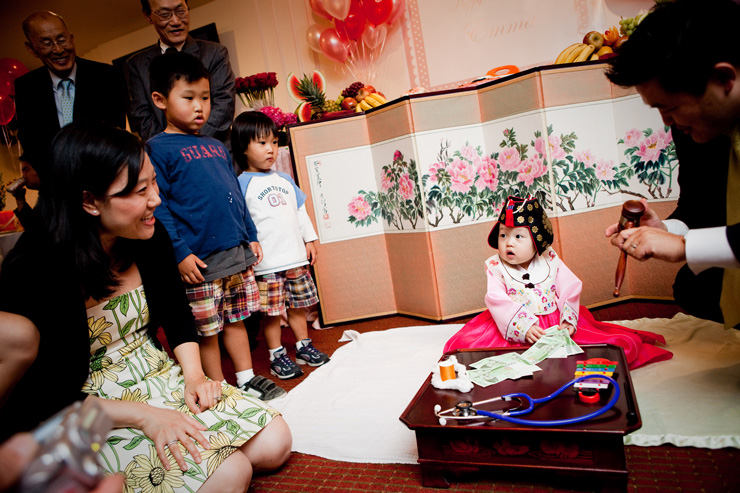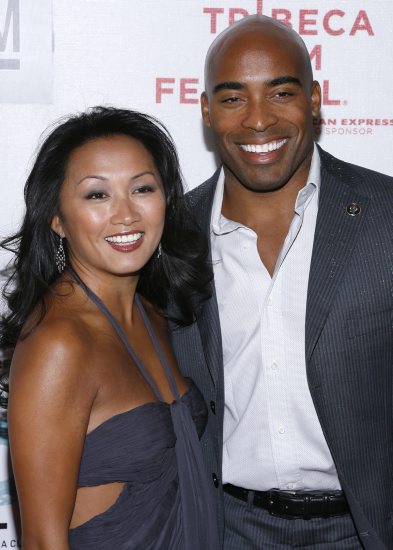Not to be outdone by the Kims next door, parents are going all-out for Number 1
By Ellyn Pak
I never thought I would be one of those moms. A working mother, with simple no-frills taste, I struggle to get home on time just to put a decent meal (I’m a fan of three-ingredient dinners) on the table. But there I was at 4 in the morning, painstakingly glueing dried beans, Skittles and pink glitter onto handmade pillars. I had successfully channeled my inner Martha Stewart.
What had gotten into me? Something even more fierce than peer pressure: dol pressure. You know, that rite of passage for ethnic Korean kids turning—drum roll—1 year old! Yes, much ado about a birthday party for a kid who can’t even properly chew the celebratory tteok (sticky rice cake) or, better yet, won’t remember a single minute of the affair.
But before you pass judgment on me, you should know there are many more Korean American parents who have gone way above and beyond in these celebrations. You may be one yourself.
“It’s funny, it’s like a mini-wedding when you have the parties nowadays,” observed Esther Min, co-founder of the Little Seouls online store that sells hanboks and other dol-related merchandise. The 38-year-old mom launched the business with her sister to be a resource for adoptive and Korean American families. In recent years, she says she’s seen a surge of interest at her online store in such items as customized dol invitations and dolgoims, the decorative towers placed on the birthday baby’s head table.
“I think they want to make it extra special and big,” Min said of the children’s families. “There must be some competition out there, especially with Koreans. I think a lot of it has to do with the grandparents. They want their grandkids to have ‘the big dol party.’ ”
In my case, my immigrant parents never so much as nudged me to throw a doljanchi (party). In fact, they seemed genuinely surprised that I wanted to have one, given the fact that my husband, a Filipino American, and I opted not to do a traditional Korean wedding ceremony (paebaek), as some couples do.
Of course, Ella being our first child, it was a no-brainer that we’d throw a big bash when she turned 1. But I also felt the desire to honor part of her heritage—one that I hope never gets lost in the shuffle of her third-generation, multicultural life.
Ironically, though these celebrations are meant to pay homage to our Korean heritage, Min of Little Seouls online store noted today’s parties don’t “even look like a traditional dol anymore.”
In the old days, when infant mortality rates were high in Korea, the 1-year gathering went something like this: Towers of various rice cakes, fruits, dates and other foods were stacked up high on the dolsang (table), representing the baby’s fortune and good life. The baby wore a hanbok and was given a tiny gold ring, if their families could afford one.
Modern-day families often do stay true to these aspects of the tradition, although many today buy or rent plastic towers of pretend tteok to adorn the dolsang. Another fun part of the bash that today’s Korean Americans tend to follow is the doljabi, which involves placing certain items in front of the baby to determine his or her future. Items can include a book or pencil, representing wisdom; money or rice representing wealth; a spool of thread signifying long life; dates for many descendants; and a hammer signifying strength.
But unlike our ancestors, some of today’s Korean American families are spending thousands of dollars renting out hotel ballrooms for the occasion, decorating the banquet hall with huge balloon arches with matching animal-themed centerpieces, and even hiring a professional photographer to document the special day.
“If you do the math, I mean, I know some people who have had weddings for far less,” said Jennifer Kim, a Northern Virginia-based photographer who shoots dol parties and first birthday portraits. “If [some couples] couldn’t do certain things for their weddings, like get nicer invitations or a nice cake, they wanted to make it up [through] their their child’s dol.”
With Kim’s circle of girlfriends holding dol parties for their children, each seemingly more elaborate than the last, her two-year-old business is growing quite naturally. “There’s a huge trend for it now,” she said. “I would say for the most part, it’s about families and friends getting together. It’s pretty much the same thing [as in the past]. It’s just different decorations.”
Different decorations, indeed. For my first birthday in 1981, my parents—who had just immigrated to the United States five or so years earlier—invited friends and family members to their tiny Takoma Park, Md., apartment for a homemade Korean meal, mounds of tteok and fruit, birthday cake and some karaoke.
I’m sure it was a nice celebration, but I wanted Ella’s dol to trump my own. As the first person among my circle of friends to have a child, I also heaped on self-imposed pressure to set the bar high. I obsessed for months about the grand details: Ella needed the perfect party dress, along with a custom made hanbok. Her birthday cake had to be a one-of-a-kind. The table decorations had to be handmade.
I surprised myself with such fixation on throwing the perfect party. Fortunately, after a few months in this obsessive party planning fog, I gradually crept out and reminded myself exactly why we were celebrating Ella’s milestone in the first place. And it helped that my husband slapped me back down to earth with a budget.
“It’s becoming a little more stressful than it should be,” said JoAnn Hwang, a 34-year-old Los Angeles-based mom who began planning her daughter Avery’s upcoming 1-year party about six months ago. “When I was ignorant, I was blissful.”
Her brother and sister-in-law held a grand party for their child in September, spending a whopping $20,000. “Oh my God, this is better than my wedding,” Hwang thought as she entered the country club filled with balloons, flowers and the dolsang. She was stunned by the filet mignon lunch and full bar, the magician and the face painter.
“For our baby, it’ll be a barbecue,” she and her husband Paul said initially. “None of this spending a fortune to do all this, putting on the hanbok, all that stuff. But then we saw the nieces’ dols and totally loved it. And we saw how much our white friends loved it. They were fascinated by the whole thing.”
“It’s important to carry on the Korean tradition with our kids,” Hwang added. “I would love for [Avery] to speak Korean and to know about different cultural traditions. I want to give her this experience, although she won’t remember. At least in pictures and videos, I want her to have a memory of her first birthday, but different from what [non-Korean] American kids get.”
So the planning began last November. She decided she’d throw a more traditional doljanchi at Yongsusan, a Los Angeles Koreatown restaurant popularly used as a 1-year party venue. She hired a party planning company to help decorate the head table. Her mother-in-law offered to bring a hanbok from South Korea. Trying not to blow a ton of money, she enlisted the help of friends to make flower arrangements and her own dol towers made out of beads.
Caroline and James Pak, also from Los Angeles, decided to mark daughter Emma’s first at the Dragon Restaurant in Koreatown, thinking the Chinese-Korean cuisine would provide mass appeal to their guests, which included non-Asians. They had been to numerous dols, including one at the posh Hotel Bel Air, and knew that wasn’t the way they wanted to go.
“I think it’s funny. Some people spend a lot of money because they have the resources to do so and maybe for some people, it’s an element of being flashy and showing off almost to the point where it’s a turn-off,” said Caroline. “It’s a total love-hate of your own culture.”
Certainly, some Korean Americans have gone the atypical route. Sarah K. Chen of Tustin, Calif., held her daughter Ellie’s dol at a local park. There were animals for children to pet and sugary treats like cotton candy. She and her husband Jeff, a Taiwanese American, knew they didn’t want all the fancy table set-ups and balloon arches, and even decided not to buy any tteok.
They did, however, dress up Ellie in a hanbok. “We wanted something more casual,” Chen said. “We wanted to do something for us, for her, for our families, but something a little more fun.”
For adoptive parents like Inge and David Scheinfarb, it’s the heritage part, versus a pressure to outdo parental peers, that serves as the main motivator to throw dol parties for their South Korean children.
The couple adopted son Jacob, 4, when he was three-and-a-half months old and daughter Sarah just last August when she was eight months old. Inge said she and her husband make the effort to learn about the Korean culture so they can impart that knowledge to their children, who have second middle names in Korean.
First birthdays are also a big deal in the Dutch culture, said Inge, whose family is from Holland and speaks the Dutch language. “So for me, birthdays are already important,” she said. “It’s even more important for such a big ceremony that’s part of the Korean culture. From what I read and what I understand, that’s a milestone. I wanted to do it and do it right.”
The Scheinfarbs threw a party with 70 guests for Jacob, decking out their West Los Angeles home with balloons, dolgoim towers and ordering Korean food. They also had a doljabi ceremony where Jacob picked money and string that would bring him future wealth and a long-lasting life.
Coincidentally, Jacob also officially become a U.S. citizen and part of the Scheinfarb family on his actual first birthday. Sarah’s dol last December was held at a Marina del Ray hotel with about 60 people.
“It’s a lot of hard work, but it pays off,” said Inge. “I think it’s important to honor the country that gave me my children and ensure they know where they come from.”
My Ella’s party was filled with laughter, hugs and lots of pink. We all loved watching the baby dig her fingers into the frosting of her cake, and it was hilarious watching our friends root for Ella to pick a certain item during the doljabi. (She ended up choosing a pencil to her writer mom’s chagrin.)
I have to say, I was proud of the beautiful dolsang, decorated with the handmade pillars, family photos, mountains of tteok and lovely pink frosted cupcakes. But, certainly, the best parts had nothing to do with all the window-dressing.
It was the sheer joy on my parents’ face as they proudly watched their grandchild tot around in a dress representative of their heritage. It was being able to share a once-in-a-lifetime moment with the most important people in our lives.
In that sense, it was like a wedding, but with Ella now a part of our lives, the love in the room was that much greater.







